Saturated fat has been known for decades as being a “bad” or “unhealthy” type of fat. However, the truth is saturated with complexity.
For example, specific types of saturated fats and different foods rich in these fats can vary in how they affect our health. These fats can also impact each of us differently depending on our genetic vulnerabilities.
For most people, however, this “bad” fat actually has a neutral or positive effect on health, particularly when consumed as a part of a carb restricted diet.
So, what does this mean for you and your low-carb diet? Let’s take a look at saturated fats from the following perspective to find out:
- What is saturated fat? The dietary definition
- The technical definition of saturated fat
- The three categories of saturated fatty acids
- Examples of saturated fats from each category
- Coconut oil — An example of how these fats affect our health
- Is saturated fat “bad”?
- Saturated fat benefits
- Healthy sources of saturated fat for low carb diets
- Healthy low-carb recipes that are high in saturated fat
- How much saturated fat should you eat for optimal health?
- Practical takeaways
What is Saturated Fat? The Dietary Definition
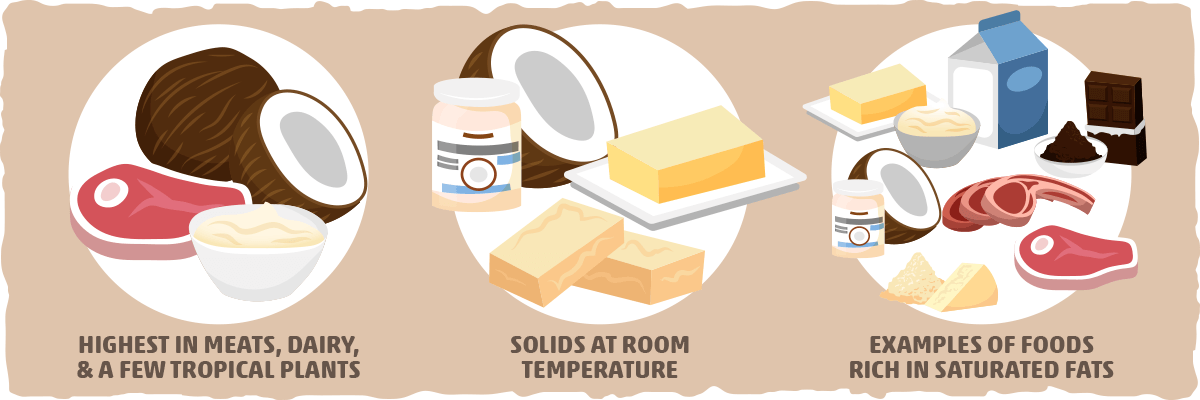
Saturated fat is a type of fat found in the highest quantities in meat, high-fat dairy products, and some tropical plants. In contrast, polyunsaturated and monounsaturated fats, which are commonly known as the “healthy” fats, are typically the predominant fats found in nuts, seeds, olive oil, vegetable oils, and other plant foods/oil.
Additionally, fats that are mostly saturated (like butter, tallow, and coconut oil) tend to be solid at room temperature, while fats that are mostly unsaturated (like olive oil) are liquid at room temperature.
Popular examples of foods rich in saturated fats are fatty cuts of beef and lamb, butter, heavy cream, cheese, coconut oil, and dark chocolate. Many of these foods carry a stigma simply because they are the top sources of saturated fat in our diets.
Although the consensus around these fats seems to be shifting, many still believe that foods high in saturated fat are bad for our health. As you will learn throughout this article, this is an oversimplification of the science that fosters the growth of this “bad” fat myth.
The truth is that saturated fat-rich foods can enhance health when consumed as a part of a healthy diet, such as a well-formulated low-carb diet or keto diet.
Context is crucial with all natural fats we consume. Even fats that are commonly crowned as being “healthy” can be harmful.
To help us develop a better understanding of saturated fat, we must “trim the fat” from these stigmatized fatty acids.
What is Saturated Fat? The Technical Definition
Unearthing the reality of these fats requires us to start with an objective foundation. From a biochemical perspective, saturated fats get their name from the fact that their fatty acids consist of single-bonded carbon molecules that are entirely “saturated” with hydrogen atoms.
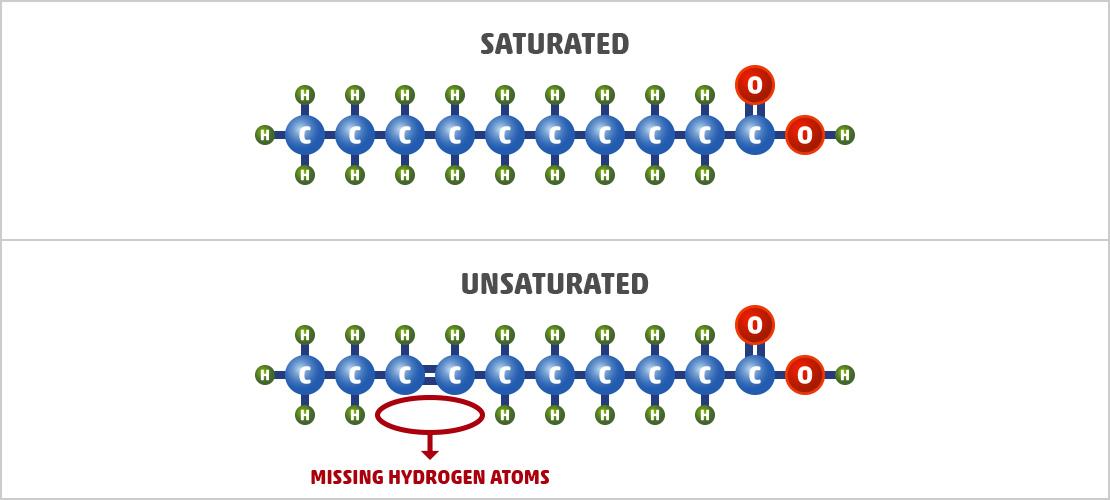
In contrast, all unsaturated fats have at least one double bond, making them “unsaturated” with hydrogen atoms. This means that monounsaturated fats and polyunsaturated fats both have at least one double bond.
The number of double bonds (or lack thereof) in the fatty acid significantly changes how the body processes it and what effect it has on health. The length of the fatty acid chain plays a crucial role as well.
Different saturated fatty acids are named and categorized based on the number of carbons molecules they have. Their length largely determines what impact they have throughout the body.
For example, capric acid (commonly found in coconut oil, palm oil, and breast milk) has 10 single-bonded carbon atoms, and palmitic acid (also found in coconut oil and palm oil) has 16 single-bonded carbon atoms.
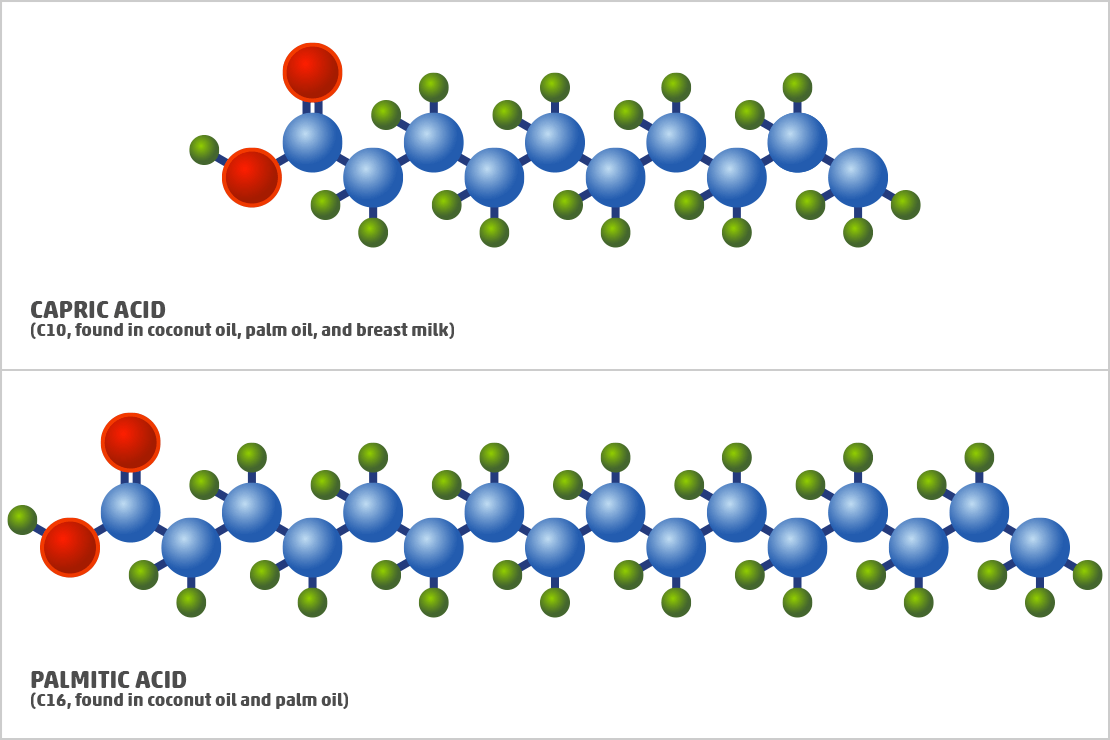
They follow completely different digestive and metabolic pathways in the body, resulting in different effects on our health. Many of these effects are beneficial, while some can be negative.
Overall, the category of saturated fats, in itself, is filled with so much nuance that it is misleading to label all saturated fat as being “bad.”
To help us simplify some of these complexities, let’s take a look at the various ways that saturated fatty acids are found in our food.
The Three Categories of Saturated Fatty Acids
Before we breakdown the categories of these fats, it’s crucial that we clear up some semantics.
Both saturated and unsaturated fats typically exist in the form of triglycerides. A triglyceride is a molecule consisting of three fatty acids attached to a glycerol backbone.
As an example, medium chain triglyceride oil, commonly known as MCT oil, predominantly consists of triglycerides with three medium-chain saturated fatty acids.
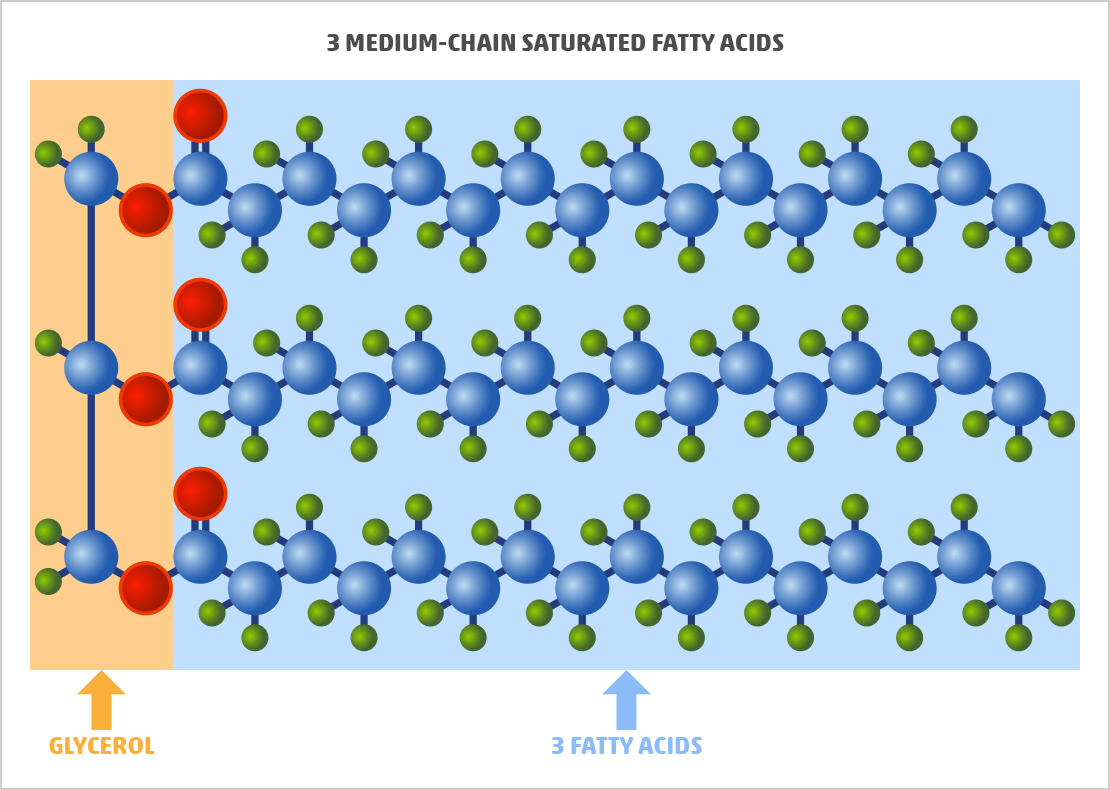
In most cases, the terms “fatty acids” and “fats” are used interchangeably because the fatty acids are responsible for the properties and health effects of the triglycerides we consume.
With this concept of mind, let’s add some more color to saturated fats. Here are the three categories of saturated fatty acids:
- Short chain fatty acids (SCFAs) — These saturated fatty acids only contain 2-5 carbon atoms. They are produced when the friendly gut bacteria ferment fiber in your colon and are the primary source of energy for the cells lining your colon. You can also get them in small quantities from butter in the form of a short-chain triglyceride known as butyrate.
- Medium chain fatty acids (MCFAs) — Typically known as medium-chain triglycerides (MCTs), MCFAs consist of 6-12 carbon atoms. They are relatively small compared to most of the fat we consume. This allows most of them to be digested directly to the liver, where they provide the molecules needed to increase ketone production.
- Long chain fatty acids (LCFAs) — Most of our fat intake comes from LCFAs, which have 13 or more carbons. All monounsaturated fats and polyunsaturated fats fall into this category as well, but we will focus on long-chain saturated fatty acids throughout this article.
Examples of Saturated Fats from Each Category
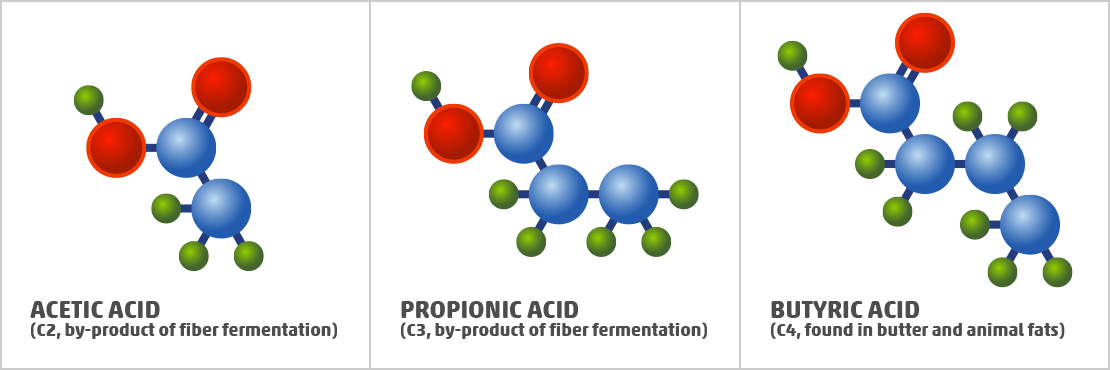
The most common saturated fats in the human diet are long-chain fatty acids, particularly myristic acid, stearic acid, and palmitic acid. Medium-chain and short-chain fatty acids typically represent a much smaller portion of our saturated fat intake. Let’s take a look at common examples of each one:
Long-chain Saturated Fatty Acid Examples
- Myristic acid — A saturated 14-carbon fatty acid occurring in most animal and vegetable fats, particularly butterfat and coconut, palm, and nutmeg oils.
- Stearic acid — The main dietary source of this 18-carbon fatty acid is animal fat. You can also find it in palm and coconut oil.
- Palmitic acid — This 16-carbon fatty acid makes up the majority of the total fat in meat and dairy products. It is also the most common saturated fatty acid found in the human body.
Medium-chain Fatty Acid Examples
- Lauric acid — This 12 carbon fatty acid makes up approximately 47% of palm kernel oil and 42% of coconut oil, while other foods only contain a trace of it. Lauric acid shares many properties with the long-chain saturated fatty acids (i.e., by raising HDL cholesterol and following similar digestive pathways), so they are occasionally considered as long-chain fats.
- Capric acid — Just ten carbon atoms long, this MCFA is small enough to skip normal fat digestion and go straight to the liver where it can be converted into ketones. It makes up 10% of MCTs in coconut oil.
- Caprylic acid — With two fewer carbons than capric acid, caprylic acid can be converted into ketones more quickly and efficiently. It makes up 12% of the MCTs found in coconut oil.
Short-chain Fatty Acid Examples
- Acetic acid — With just two carbons, this fatty acid is typically created as a by-product of fiber fermentation in the gut and incorporated into other fats and cholesterol.
- Propionic acid — A three-carbon fatty acid that is also the result of fiber fermentation in the gut, but it typically enters the liver to be converted into glucose.
- Butyric acid — This four-carbon fatty acid makes up a small percentage of the fatty acids in butter and other animal fats. It is also produced in the gut and confers various health benefits throughout the body.
Altogether, the long-chain saturated fatty acids represent the majority of the calories we get from saturated fat. In this category alone, there are fatty acids that have the potential to increase cholesterol levels, decrease cholesterol levels, or keep them the same.
This potential to raise cholesterol levels, specifically LDL cholesterol, is one of the main reasons why saturated fat is commonly known as “bad.” However, this leads to a needless phobia of fatty foods that can actually help optimize cholesterol.
To give you a better idea of what I mean, let’s take a look at coconut oil — one of the healthiest oils that also happens to be one of the richest in saturated fat.
Coconut Oil — A Mixture of Saturated Fats that Can Improve Health
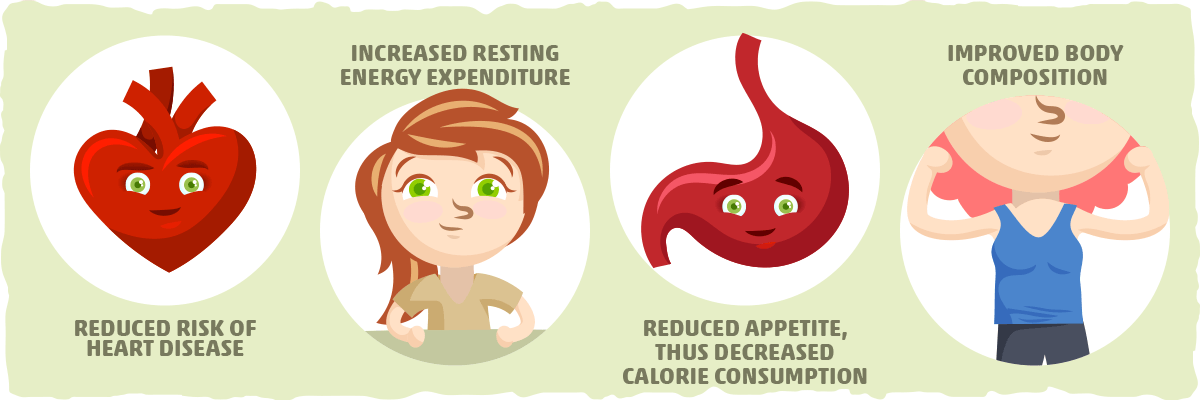
Many health professionals gasp when they see a food item with as much saturated fat as coconut oil. Since some saturated fats have been found to raise LDL cholesterol (also known as “bad” cholesterol), they jump to the conclusion that coconut oil will do the same and increase the risk of heart disease. (As we will learn in the next section, this conclusion is based on faulty assumptions.)
By holding on to these short-sighted beliefs, we end up avoiding on some of the foods that may actually help prevent the very conditions we are told they will cause. The perfect example of this is coconut oil.
About 70% of coconut oil is composed of medium-chain triglycerides (MCTs), mostly lauric acid.
This fatty acid, in particular, has been found to reduce the total-to-HDL cholesterol ratio. These changes are associated with a reduced risk of heart disease.
In fact, lauric acid appears to have more beneficial effects on HDL cholesterol levels than any other saturated fatty acid.
Additionally, high-quality data indicates that the MCTs found in coconut oil may also:
- Increase resting energy expenditure compared to long-chain fatty acids.
- Reduce appetite in a way that leads to significant decreases in calorie consumption.
- Improve body composition when substituted for long-chain fats.
If you’d like to learn more about the research behind these findings, check out our article on coconut oil.
This isn’t the only example of a demonized food that benefits health. Other whole foods that are filled with saturated fat, such as fatty meats, cheese, and butter, can be a healthy part of our diets as well, especially when following a ketogenic diet or non-ketogenic low-carb diet.
In fact, you’ll find many of these foods on our list of top 10 foods for the ketogenic diet. Thus, a more accurate depiction of saturated fats is that they are only “bad” or “unhealthy” under specific contexts.
Is Saturated Fat “Bad”? The Truth Behind These Vilified Fats
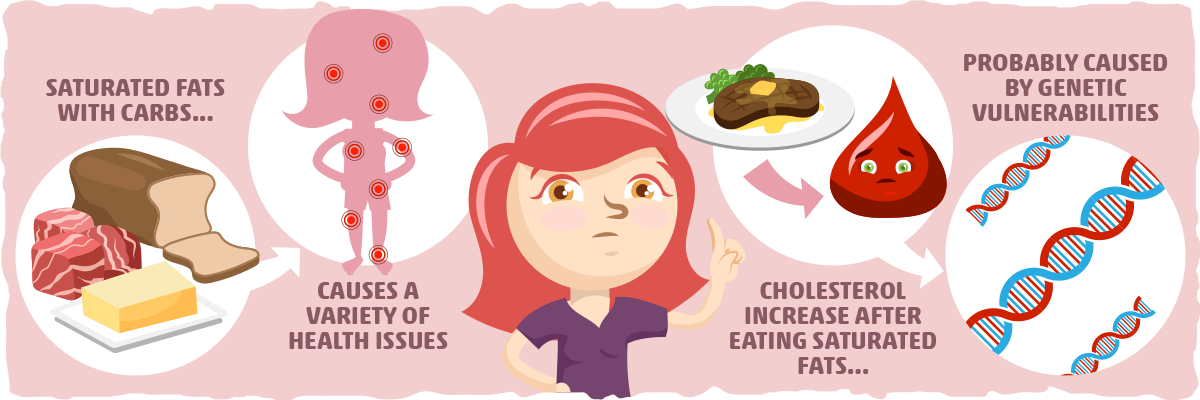
Unlike artificial trans fat, which is a “bad” fat that is undeniably unhealthy, saturated fat is only guilty by a poorly-founded association (with heart disease). Back in the 20th century, when heart disease first became the number one cause of death in the US, researchers put together the limited data they had at the time into what is known as the diet-heart hypothesis.
This hypothesis stated that if saturated fat raises cholesterol and cholesterol causes heart disease, then this must mean that saturated fat causes heart disease.
Although this was solely based on observational data and animal studies, it was used as the basis for the “heart-healthy” low-fat diet that replaced saturated fat and trans fat with unsaturated vegetable oils.
The current data, however, contradicts the viability of these recommendations. For example, a 2016 analysis and re-evaluation of the hypothesis concluded that:
Available evidence from randomized controlled trials shows that replacement of saturated fat in the diet with linoleic acid [an omega-6 fatty acid] effectively lowers serum cholesterol but does not support the hypothesis that this translates to a lower risk of death from coronary heart disease or all causes.
Other meta-analyses of the current data have led to similar conclusions. This is likely because linoleic acid, as well as other polyunsaturated fats, are much more vulnerable to oxidation than saturated fats. When these fats oxidize, they form toxic compounds that can increase inflammation and contribute to atherosclerotic plaque buildup.
Some research even indicates that replacing saturated fat with vegetable oils that are high in omega-6s can increase small, dense LDL particle levels, which are regarded as the most harmful type of LDL. Long-chain saturated fatty acids, on the other hand, have been found to increase the size of LDL particles, making them less likely to contribute to heart disease.
Simply put, saturated fat isn’t objectively unhealthy. It was only thought to be “bad” because of the limited understanding we had of heart disease in the 20th century.
Now, we have overwhelming evidence pointing to the fact that reducing saturated fat intake has no effect on the risk of heart disease or death. Along with that, some data suggest that replacing saturated fat with refined carbs or processed oils can increase cardiovascular disease risk and mortality risk.
That being said, there are two instances when saturated fat can be “bad” or “unhealthy”:
- When a diet is high in both saturated fat and refined carbohydrate. This diet, which resembles the standard American diet, can cause chronic low-grade inflammation, promote insulin resistance, and increase atherogenic cholesterol levels. Altogether, this significantly increases the risk of obesity, type 2 diabetes, and cardiovascular disease. One of the most effective ways to reduce your risk of these conditions is by following a low-carb diet.
- When someone notices their cholesterol increase to unhealthy levels after they increase their saturated fat consumption. This will typically only happen if you have one or more genetic variants that make you vulnerable to having higher LDL. For a more comprehensive look at this topic, check out our article on keto and cholesterol.
The overwhelming theme for saturated fats (and all other natural fats) is that context is key. Genetic variants, food/fat quality, and carb consumption all play a role in how saturated fats affect our health.
For most people, saturated fat is safe and should not be avoided in favor of vegetable oils (as is typically recommended by low-fat proponents). In fact, each category of saturated fat has been found to be beneficial in several ways, particularly when refined carbs and other processed foods are replaced by the saturated-fat-rich foods that are commonly consumed on keto.
The (Rarely Recognized) Benefits of Saturated Fat
Despite the negative stigma surrounding them, saturated fatty acids are crucial for optimal health. All three types — long-chain, medium-chain, and short-chain saturated fatty acids — can provide us with significant benefits, ranging from improving heart health to helping us burn and lose fat.
Let’s take a closer look at some of the most noteworthy benefits of each category of saturated fats. Below, you’ll find a graphic summarizing the benefits of saturated fat. Keep scrolling to see the plain text information:
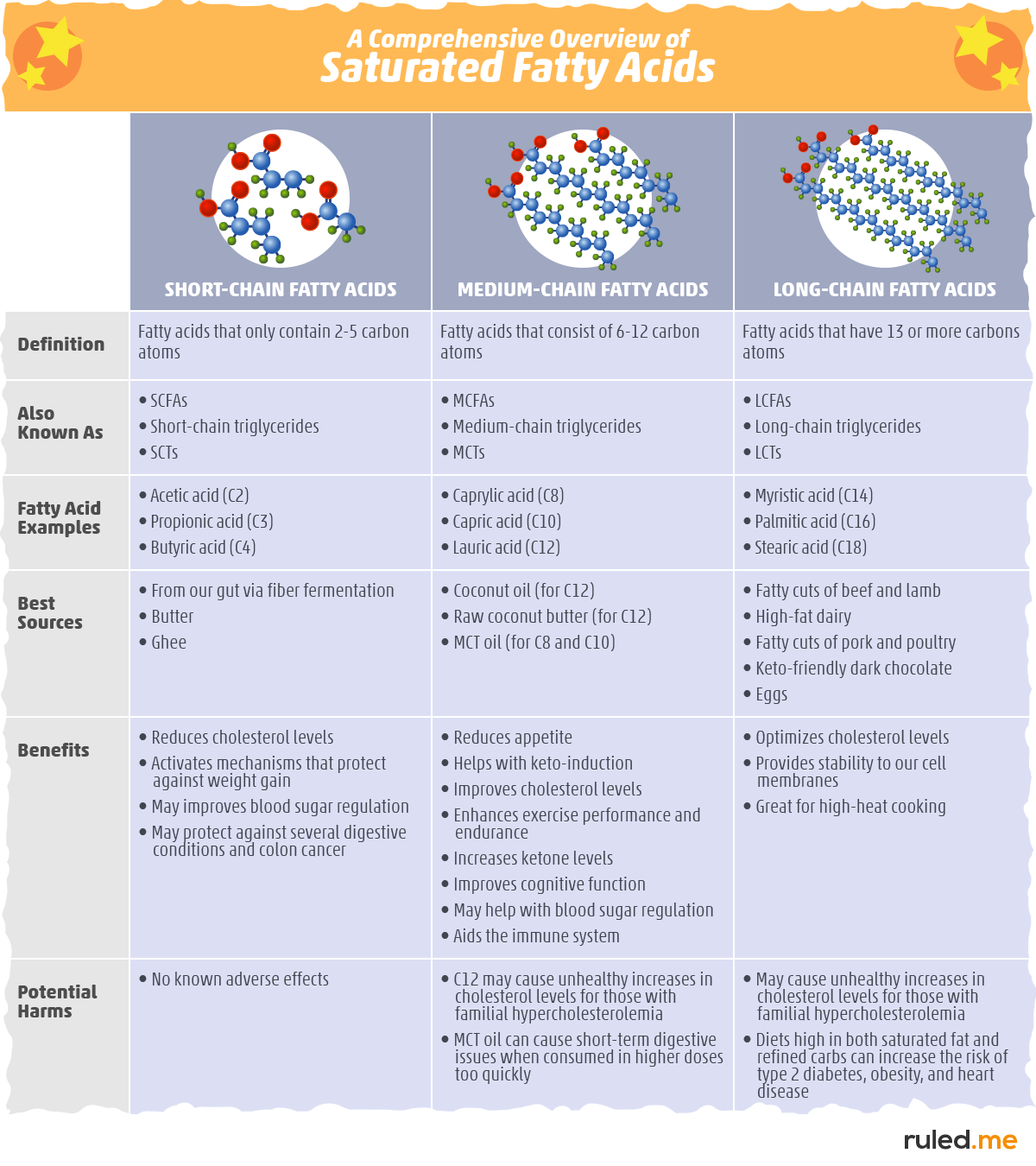
Benefits of Long-chain Saturated Fatty Acids
These fats represent the majority of the saturated fats most people consume in their diets. Although many of these long-chain fats have a bad reputation for increasing LDL cholesterol, they actually play a crucial role in improving overall health when consumed as a part of a healthy diet.
Here are some of the science-backed benefits of long-chain saturated fatty acids:
- Optimize cholesterol levels. For most people, saturated fats raise HDL (the “good”) cholesterol and change LDL from small, dense to Large LDL, which is mostly benign. The addition of saturated fat to the diet also has been found to reduce the levels of a substance called lipoprotein (a) that is highly correlated with heart disease risk. Altogether, these changes represent a beneficial change in cholesterol levels, favoring particles that are less likely to cause plaque buildup in our arterial walls.
- Provide stability to cell membranes. Saturated fats are less prone to oxidative damage than their unsaturated counterparts, which makes them a key component of cell membranes. Cell membranes that lack sufficient saturated fatty acids tend to be more “leaky’ and vulnerable to damage.
- Great for high-heat cooking. Fats that mostly consist of saturated fat, like coconut oil, are great for roasting, baking, sautéing, grilling, or frying. This is because they only have single-bonded carbons, which makes them more resistant to oxidation and damage caused by high-heat cooking. In contrast, oils high in polyunsaturated fats are highly susceptible to oxidation, turning what was potentially healthy fat into a toxic compound.
The Unique Benefits of Medium-chain Saturated Fatty Acids
Here is a brief summary of the benefits of medium-chain fatty acids, which are commonly consumed as medium chain triglycerides or MCTs:
- Reduce appetite. Studies show that supplementing with MCTs can decrease hunger levels and calorie consumption at subsequent meals. This can help curb cravings and make fat loss much easier.
- Help with keto-induction. MCTs are directly converted to ketones regardless of how keto-adapted you are. This can help first-time keto dieters enter ketosis much more quickly while reducing keto flu symptoms.
- Improve cholesterol levels. Clinical trials have discovered that MCTs can help lower LDL/HDL ratio, reduce total and HDL-cholesterol, increase HDL, and decrease LDL. Lauric acid seems to be the MCT responsible for many of these changes.
- Enhance exercise performance and endurance. The current data suggests that MCTs have the potential to objectively and subjectively improve performance.
- Increase ketone and energy levels. MCTs (except for most of the lauric acid we consume) go straight to the liver and stimulate ketogenesis. As a result, our ketone levels increase, and our cells start burning ketones, which is a much more efficient fuel source.
- Improve brain health and cognitive function. Studies have shown that MCTs can help boost cognitive function in individuals with mild to moderate cognitive impairment. People who have other neurological conditions, including Parkinson’s disease, epilepsy, gliomas, and autism, may benefit from MCTs as well.
- May help with blood sugar regulation. Several studies have found that MCTs can help improve insulin sensitivity (which is an essential component of diabetes prevention and treatment) in both diabetic patients and non-diabetic subjects.
- Aid the immune system. MCTs have been found to act as a natural antiviral and antibiotic, helping the body defend against several different infections.
Overall, MCTs provide a wide range of benefits, and MCT oil is a great supplement to add to any health improvement arsenal. For more information on MCTs and their benefits, check out our comprehensive guide to MCT oil.
The Unique Benefits of Short-chain Fatty Acids
Don’t forget about the little guys. Short chain saturated fats play a role in optimizing our health as well.
- Reduce cholesterol levels. Acetic acid, propionic acid, and butyric acid have all been found to decrease cholesterol levels via different mechanisms. More research is needed to determine the significance of these effects.
- Stimulate mechanisms that protect against weight gain. Short chain fatty acids have been found to activate multiple pathways that reduce fat storage and increase fat burning. However, clinical trials are needed to assess the potential effects of SCFAs on body fat levels.
- Improve blood sugar regulation. Some evidence suggests that butyrate can have positive effects in both animals and humans with type 2 diabetes. The proposed mechanisms are similar to those that can help protect against weight gain.
- Protect against several digestive conditions and colon cancer. Short-chain fatty acids have been shown to protect against colon cancer in animal and lab studies. However, clinical trials are needed. Butyric acid, in particular, may reduce diarrhea, help treat inflammatory bowel diseases, and reduce the severity of irritable syndrome as well.
Healthy Sources of Saturated Fat
As we did with the benefits of saturated fats, we will take a look at the healthiest sources of each type based on chain length as well.
Long-Chain Saturated Fatty Acid Sources
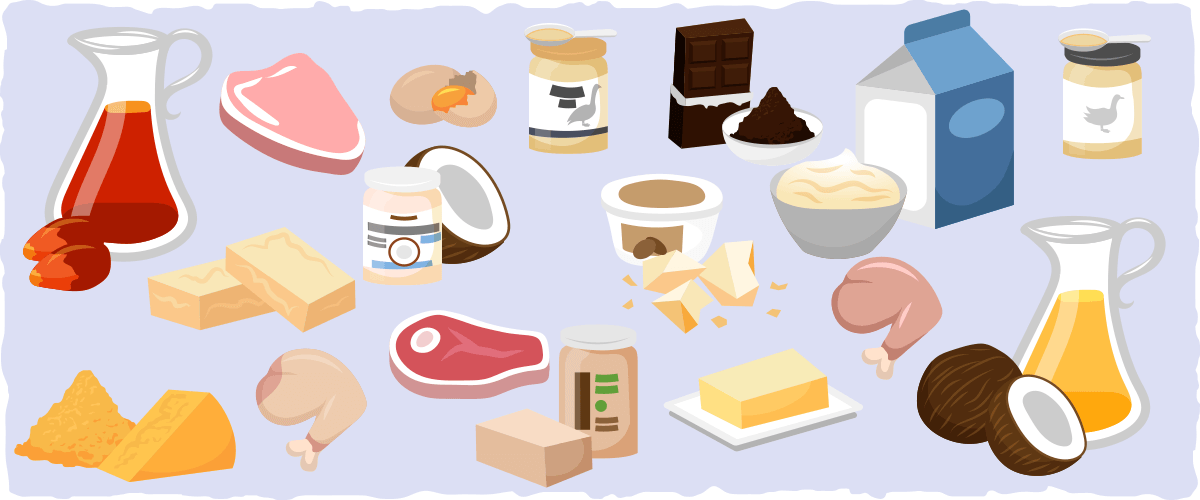
Long-chain saturated fatty acids are usually our primary source of saturated fat. They are found in highest quantities in animal fats and tropical oils.
For optimal health, the majority of these fats should come from fresh fatty meats and high-fat dairy rather than pure animal or dairy fat.
Here are some examples of keto-friendly long-chain saturated fat food sources:
- Fatty cuts of beef and lamb
- Fatty cuts of pork
- Dark chicken meat and poultry skin
- Fatty cuts of duck
- High-fat dairy foods (cheese, heavy cream, and butter)
- Dark chocolate (with minimal sugar, a keto-friendly sugar alternative, or no sweeteners at all)
- Raw coconut butter (in moderation to limit net carb intake)
- Eggs
When possible, opt for 100% grass-fed, pasture-raised beef, lamb, and dairy, as well as pasture-raised poultry, eggs, and pork. They will contain more health-promoting fats and beneficial nutrients than the conventional varieties of these foods.
By consuming most of your saturated fats from these foods, you will not only experience some of the benefits of saturated fats, but you will provide your body with essential amino acids, minerals, vitamins, and other health-promoting compounds as well.
The pure fat derived from these foods can also be used to add some extra flavor and fat to your diet. This includes:
- Coconut oil
- Cocoa butter
- Butter or ghee
- Palm oil or red palm oil (only purchase if sustainably-sourced in a way that doesn’t decimate the rainforest)
- Tallow
- Lard
- Duck fat
- Chicken fat
The fats higher in saturated fat and lower in polyunsaturated fat tend to be most stable at higher temperatures. Coconut oil, for example, is highest in saturated fat and lowest in polyunsaturated fat on this list, which makes it one of the most stable cooking fats/oils.
Best Sources of Medium-chain Fatty Acids (MCFAs)
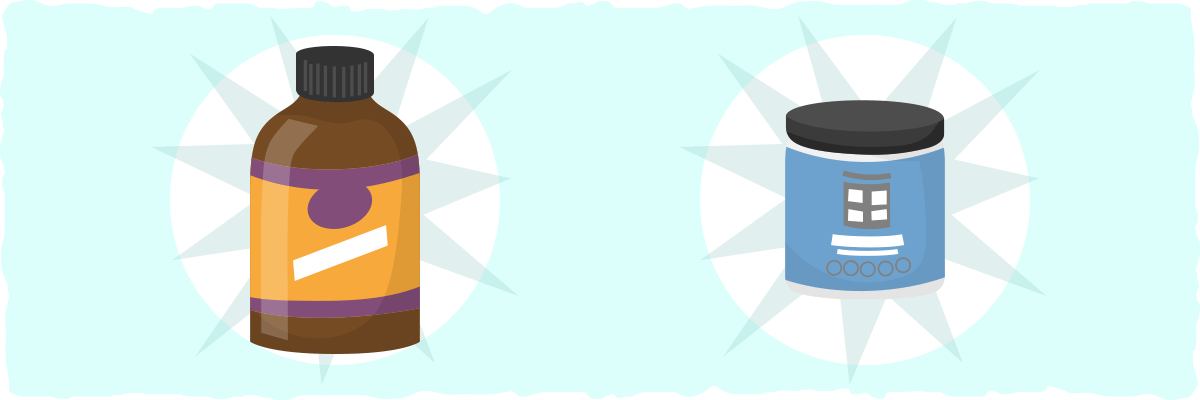
Coconut oil also is the best source of MCTs, namely lauric acid. As we learned earlier, lauric acid is the fat in coconuts that helps raise HDL cholesterol levels.
However, lauric acid will not provide you with most of the other benefits associated with the smaller MCFAs, capric and caprylic acid. Unfortunately, natural sources of MCFAs, such as coconut oil, cheese, and butter, only contain small amounts of capric and caprylic acid.
Thus, the best source of these MCFAs is MCT oil or MCT oil powder with ~100% caprylic acid (C8) and capric acid (C10).
Keep in mind, however, MCT supplements are highly-concentrated and can cause digestive issues when consumed in large doses too quickly. For proper dosing suggestions and more info on MCT oil and MCT powder, please read through our MCT oil article.
Best Sources of Short-chain Fatty Acids (SCFAs)
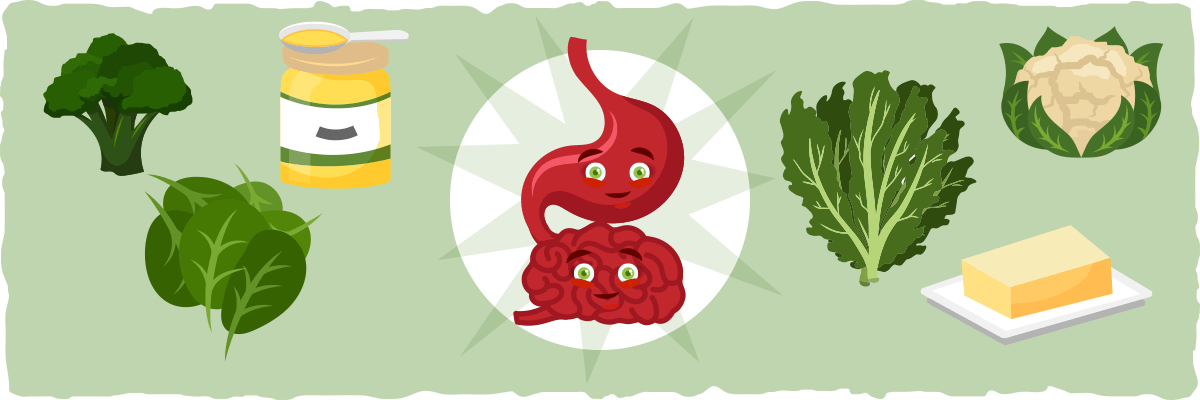
The healthiest source of butyrate is in your gut. More specifically, the by-products of fiber fermentation in the colon is how we get our short-chain fatty acids in a way that promotes gut health and overall health.
This is part of the reason why it is crucial to eat low-carb vegetables on your keto diet. Not only are these vegetables packed with nutrients, but they feed your gut with the fiber it needs to produce SCFAs.
You can also find the most well-studied SCFA, butyric acid, in high-fat dairy products. The best dietary source is 100% grass-fed butter and ghee, but only a small percent of their fats are made up of this SCFA.
There are a few short-chain triglyceride (SCT) supplements on the market as well, but the research on them is sparse and inconclusive.
Altogether, the healthiest source of SCFAs would be from 100% grass-fed butter (or ghee) melted on top of your favorite low-carb vegetable dish or a slice of keto bread.
Healthy Recipes High in Saturated Fat
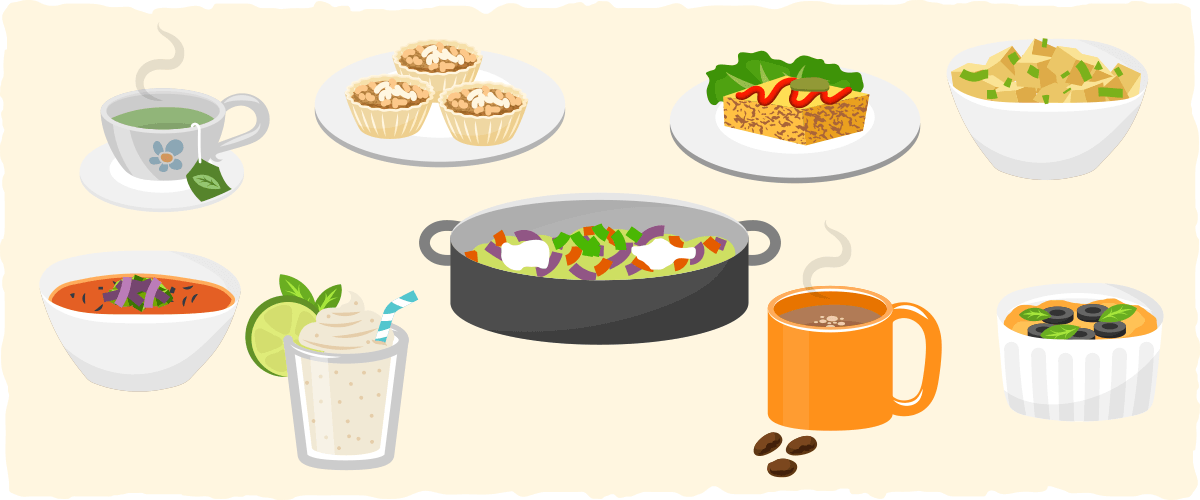
The following keto friendly recipes feature many of the healthy saturated fat sources mentioned above.
Low Carb Breakfast Recipes High in Saturated Fat:
- Ketoproof Coffee or Green Tea (use MCT oil instead of coconut oil for more MCTs)
- Blueberry Banana Bread Smoothie
- Vegetarian Three Cheese Quiche Stuffed Peppers
- Keto Sausage Breakfast Casserole
Low Carb Lunch Recipes High in Saturated Fat:
- Buffalo Chicken Crust Pizza
- Vegetarian Red Coconut Curry
- Fat Boost Smoothie with Coconut Chantilly Cream
- Beef Salpicao
Low Carb Snack Recipes High in Saturated Fat:
- Keto Tropical Smoothie
- Bacon & Cheese Cauliflower Muffins
- Coconut Cream Yogurt
- Personal Pan Pizza Dip
Low Carb Dinner Recipes High in Saturated Fat:
- Keto Gyros
- Skillet Browned Chicken with Creamy Greens
- Bacon Cheeseburger Casserole
- Keto Broccoli and Cheese Soup
Low Carb Sides that are High in Saturated Fat:
Low Carb Dessert Recipes High in Saturated Fat:
- Keto Chocolate Silk Pie
- Coconut Raspberry Slice
- Chocolate Chunk Avocado Ice Cream
- Keto Grasshopper Cheesecake Bites
How Much Saturated Fat Should You Eat for Optimal Health?
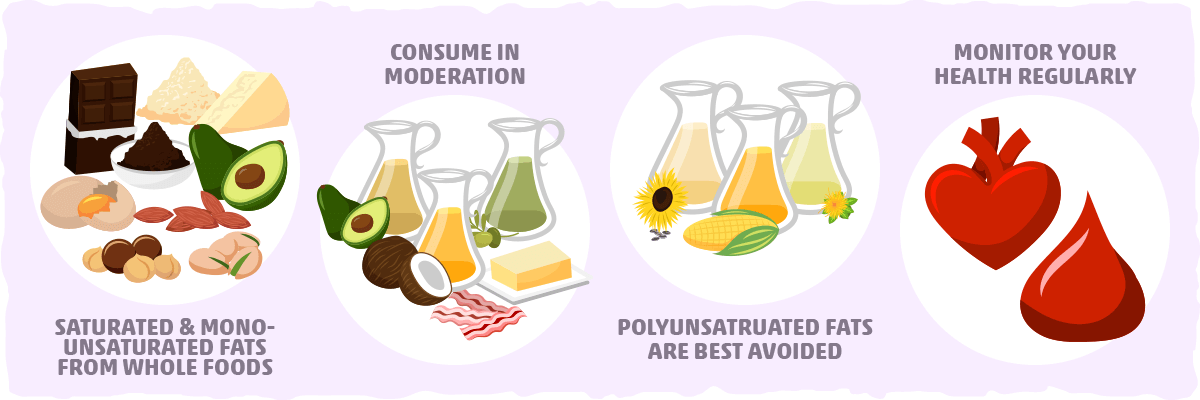
The general guidance is to limit saturated fat consumption, but as we learned throughout this article, this is not necessary for most people. This is particularly true when we follow a low-carb diet.
While on a high-fat, low-carb diet, saturated and monounsaturated fat should represent the bulk of calories you consume. For optimal health, most of these fats should come from whole, minimally-processed foods like fatty meats, high-fat cheese, keto-friendly dark chocolate, avocados, eggs, and high-MUFA nuts.
Pure animal fats, coconut oil, and MCT oil should be used in moderation along with extra virgin olive oil, avocado oil, and other high-MUFA oils to help meet your fat needs. Any oils that are high in polyunsaturated fats — such as safflower oil, sunflower oil, soybean oil, cottonseed oil, and corn oil — are best avoided.
When making any significant dietary change, make sure you are monitoring your health. Although most people experience incredible health improvements while following a low-carb diet, a small subset of the population with specific genetic variants may not respond well to higher saturated fat intakes. These individuals may benefit from the recommendations outlined in the “What if Keto is Making Your Cholesterol Levels Worse?” section of our Ketogenic Diet and Cholesterol article.
Putting It All Together — The Not-So-Bitter Truth About Saturated Fats
Saturated fats are often branded as “bad” fats because of their potential to raise cholesterol and increase heart disease risk. However, recent high-quality data from several studies have found no link between saturated fat and heart disease — and many saturated fatty acids have even been shown to improve cholesterol levels.
The truth is that context is crucial when it comes to fat consumption. The combination of saturated fat and refined carbs, for example, can set us up for heart disease, type 2 diabetes, and obesity, while replacing carb consumption with fat-rich foods can help prevent and reduce the severity of these conditions.
This explains why keto diets have been found to optimize blood lipid levels rather than make them worse (as many researchers would have thought).
Many of the saturated fatty acids have been found to have unique benefits as well — from LCFAs that help increase HDL to MCFAs that boost ketone levels and reduce appetite to SCFAs that improve gut health and decrease cholesterol levels. It is misleading to treat these fats as being universally “bad” and “unhealthy.”
To maximize the benefits you get from saturated fats, make sure to include fresh pasture-raised meat and poultry, high-fat dairy, pasture-raised eggs, low-carb vegetables, keto-friendly dark chocolate, and high-quality MCT oil in your low-carb diet.
If you need help adding some of these foods to your diet, try incorporating the following recipes into your weekly meal plan:
For breakfast:
- Ketoproof Coffee or Green Tea (use MCT oil instead of coconut oil for more MCTs)
- Blueberry Banana Bread Smoothie
- Vegetarian Three Cheese Quiche Stuffed Peppers
- Keto Sausage Breakfast Casserole
For lunch:
- Buffalo Chicken Crust Pizza
- Vegetarian Red Coconut Curry
- Fat Boost Smoothie with Coconut Chantilly Cream
- Beef Salpicao
For a snack:
- Keto Tropical Smoothie
- Bacon & Cheese Cauliflower Muffins
- Coconut Cream Yogurt
- Personal Pan Pizza Dip
For dinner:
- Keto Gyros
- Skillet Browned Chicken with Creamy Greens
- Bacon Cheeseburger Casserole
- Keto Broccoli and Cheese Soup
As a side:
For dessert:
- Keto Chocolate Silk Pie
- Coconut Raspberry Slice
- Chocolate Chunk Avocado Ice Cream
- Keto Grasshopper Cheesecake Bites
If you’d like to learn more about the other types of fats, check out our in-depth article on unsaturated fat.
For more practical information on how to lose weight, improve health and achieve amazing results with a low-carb diet, check out our beginner’s guide to keto.
Sources
- Facts about saturated fats — Medline Plus
- Palmitic Acid: Physiological Role, Metabolism and Nutritional Implications — NCBI
- The Importance of Fats in a Ketogenic Diet — Ruled.me
- Is Coconut Oil Actually Good for You? — Ruled.me
- Association of Dietary, Circulating, and Supplement Fatty Acids With Coronary Risk: A Systematic Review and Meta-analysis — Annals of Internal Medicine
- Reduced or modified dietary fat for preventing cardiovascular disease — Cochrane Library
- Saturated Fat: Good or Bad? — Healthline
- How Short-Chain Fatty Acids Affect Health and Weight — Healthline
- Fatty Acids and Triacylglycerols — University of Washington
- Gut-derived short-chain fatty acids are vividly assimilated into host carbohydrates and lipids. — NCBI
- Butyric Acid — PubChem
- Dietary saturated and trans fatty acids and lipoprotein metabolism. — NCBI
- Comparison of the effects of diets enriched in lauric, palmitic, or oleic acids on serum lipids and lipoproteins in healthy women and men. — NCBI
- Effects of dietary fatty acids and carbohydrates on the ratio of serum total to HDL cholesterol and on serum lipids and apolipoproteins: a meta-analysis of 60 controlled trials. — NCBI
- Cardiovascular disease risk of dietary stearic acid compared with trans, other saturated, and unsaturated fatty acids: a systematic review. — NCBI
- Re-evaluation of the traditional diet-heart hypothesis: analysis of recovered data from Minnesota Coronary Experiment (1968-73) — BMJ
- Effects of dietary fats on blood lipids: a review of direct comparison trials — BMJ
- Dietary fat and cardiometabolic health: evidence, controversies, and consensus for guidance — BMJ
- The role of short-chain fatty acids in the interplay between diet, gut microbiota, and host energy metabolism — NCBI
- Role of membranes in disease. — NCBI
- A palm oil-enriched diet lowers serum lipoprotein(a) in normocholesterolemic volunteers — Atherosclerosis
- Lipoprotein(a): Biology and Clinical Importance — NCBI
- MCT Oil: The Benefits, Risks, and How to Use — Ruled.me
- Evaluation of Chemical and Physical Changes in Different Commercial Oils during Heating — Acta Scientific Nutritional Health
